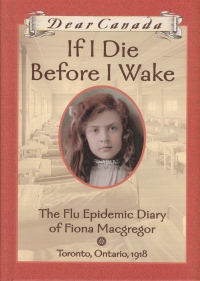| ________________
CM . . . . Volume XVIII Number 22 . . . . February 10, 2012
excerpt:
One of Jean Little's contributions to Scholastic's "Dear Canada" series, If I Die Before I Wake tells the story of the Spanish Flu epidemic from the perspective of 12-year-old Fiona Macgregor in Toronto. While the Great War is being fought overseas, people in Toronto are also facing another enemy: the Spanish Influenza. Following the format of the "Dear Canada" series, the novel is a fictional dairy of a young girl who experiences the historic moment first-hand. In this case, Fiona details her daily life though a series of diary entries she addresses to her imaginary unborn daughter, "Jane." The diary entries begin on Fiona's 12th birthday on August 3, 1918, when she gets a new diary as a gift. Fiona begins by describing her life, family, and the impact of World War I on her society. Fiona is a likable and believable narrator. She is concerned about the war and the start of flu epidemic; however, like a normal child, she also thinks about more immediate subjects, such as her chores, her conflicts with her grandmother, her new puppy, and her curiosity regarding a family secret. While not the primary subject of this novel, World War I is prominent in the story, and it naturally affects Fiona's life in many ways. Fiona's father is unable to fight because he was injured in the Boer War, but some of her elder sister's friends are casualties of the war. As Fiona matures and begins volunteering at a hospital for wounded soldiers, her understanding of the war's effect on Canadian society becomes clearer. The reader experiences the start and peak of the Spanish flu outbreak in Toronto through Fiona's writing. First, Fiona's schoolmate is one of Toronto's initial flu fatalities. Then, as the epidemic spreads, Fiona's twin sister, Fanny, becomes sick and almost dies. Finally, as the epidemic peaks and begins to lessen, Fiona's sister, Jemma, becomes fatally ill after hugging and kissing strangers in the streets on Armistice Day. As Little notes, many Canadians in Toronto and elsewhere caught the Spanish Flu while celebrating this momentous day. Little's book is well-researched and vivid, not only in its description of the Spanish Influenza, but also as a portrait of middle-class Torontonians in 1918. While the historical focus is on the flu epidemic, Little recreates a time of great change in Canadian history from the personalized perspective of Fiona. For instance, Fiona considers the woman's suffrage movement as her elder sister begins medical school. The time period is brought to life for the reader in the descriptions of social attitudes and customs of the time which are authentically woven into Fiona's diary entries. The supporting nonfiction and primary material included as an appendix (such as a copy of the Eaton's catalogue showing a Velocipede similar to the one Fiona's little brother rode, and the rules for the Macgregors' version of the card game "Pounce") only increase the reader's overall feelings of verisimilitude. Aesthetically, this book follows the format of the rest of the "Dear Canada" series, with its thick paper, ribbon bookmark and diary format. The book also includes an historical note, giving readers a background on the Spanish flu and exploring the concept of pandemic. Copies of historical documents and photographs are also included in the appendix to reinforce that this fictional story is about a real time and place. Highly Recommended. Beth Wilcox is a teacher in Ottawa, ON, and a Master of Arts in Children's Literature graduate from the University of British Columbia.
To comment
on this title or this review, send mail to cm@umanitoba.ca.
Copyright © the Manitoba Library Association. Reproduction for personal
use is permitted only if this copyright notice is maintained. Any
other reproduction is prohibited without permission.
NEXT REVIEW |
TABLE OF CONTENTS FOR THIS ISSUE
- February 10, 2012.
AUTHORS |
TITLES |
MEDIA REVIEWS |
PROFILES |
BACK ISSUES |
SEARCH |
CMARCHIVE |
HOME |
